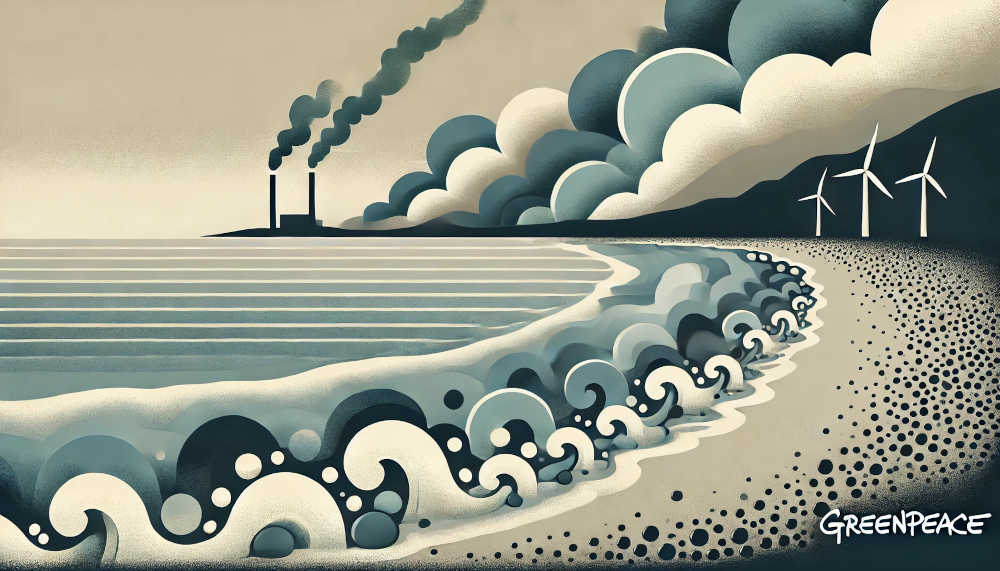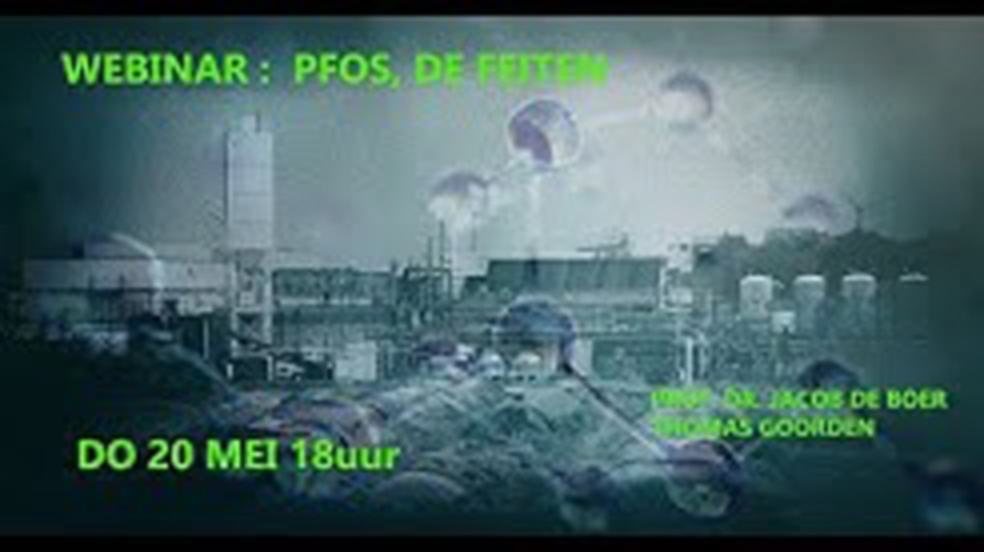12.02.2025 | Grondrecht
Analyse door Greenpeace van PFAS-vervuiling in zeeschuim aan de Duitse Noord- en Oostzeekusten
Inleiding
Per- en polygefluoreerde alkylstoffen (PFAS) staan bekend als ‘eeuwige chemicaliën’ vanwege hun hardnekkigheid in het milieu. Deze door de mens gemaakte stoffen worden sinds de jaren 1940 veelvuldig ingezet in zowel industriële processen als consumentenproducten vanwege hun water-, vet- en hittebestendige eigenschappen. Voorbeelden van toepassingen zijn skiwas, waterafstotende buitenkleding, vetbestendige verpakkingen zoals pizzadozen en bakpapier, en vuilafstotende behandelingen van tapijten en autostoelen. Ook in technische toepassingen zijn PFAS gewild vanwege hun chemische en thermische stabiliteit.
Ondanks deze nuttige eigenschappen zijn PFAS schadelijk voor zowel mens als milieu. Ze breken niet af in het milieu (persistentie), verplaatsen zich gemakkelijk (mobiliteit) en kunnen zich ophopen in levende organismen (bioaccumulatie). Hierdoor kunnen PFAS via drinkwater en voedsel, zoals vis, schaaldieren en groenten, het menselijk lichaam binnendringen en leiden tot langdurige gezondheidsproblemen.
Sinds hun introductie meer dan vijftig jaar geleden hebben PFAS zich wereldwijd verspreid. Vooral bij de productie en verwerking van PFAS-houdend afval komen deze stoffen vrij, waarna ze via lucht, water en bodem zelfs in afgelegen gebieden en in mensen worden aangetroffen. De hoogste concentraties worden doorgaans gemeten in de buurt van industriële vervuilingsbronnen of op locaties waar PFAS-houdende producten zoals blusschuim intensief zijn gebruikt.
Nieuwe inzichten en onderzoeksaanpak
Recente studies uit Zweden en Nederland hebben aangetoond dat PFAS, die via rivieren de zee bereiken, opnieuw aan land kunnen komen via zeeschuim en opspattend schuim. Omdat PFAS oppervlakteactieve stoffen zijn, concentreren ze zich in het schuim aan de kust. Onderzoeken aan stranden in België, Nederland en Denemarken hebben extreem hoge PFAS-concentraties in zeeschuim aangetoond. Aan de Deense westkust bijvoorbeeld, varieerden de PFAS-4-concentraties (PFOA, PFNA, PFOS en PFHxS) van 17.000 tot 250.000 ng/L, ver boven de Deense grenswaarde voor zwemwater van 40 ng/L.
Deze hoge concentraties verhogen het risico op blootstelling aan PFAS via direct contact of incidenteel inslikken, vooral bij kinderen. Daarnaast kan PFAS via het schuim de bodem en het grondwater vervuilen, en aërosolen in kustgebieden vergroten de kans op inhalatie van deze schadelijke stoffen.
In Duitsland ontbraken tot voor kort gegevens over PFAS-concentraties in zeeschuim, ondanks de aanwezigheid van vergelijkbare schuimvorming aan de kusten. Greenpeace heeft daarom in 2024 en 2025 steekproeven genomen aan populaire Duitse stranden om inzicht te krijgen in de PFAS-belasting.
Methodologie van bemonstering en analyse
De bemonsteringen vonden plaats in november 2024 aan de Noordzee en in januari 2025 aan de Oostzee, periodes waarin winderige omstandigheden de vorming van zeeschuim bevorderen. Monsters werden verzameld aan de Noordzeestranden van St. Peter Ording, Sylt en Norderney en aan de Oostzeestranden van Kühlungsborn en Boltenhagen. In totaal werden negen monsters verzameld.
Het schuim werd direct van het strand geschept in PFAS-vrije polyethyleen (PE) zakken, die vooraf in het laboratorium waren getest op contaminatie. Waar mogelijk werd uitsluitend schuim verzameld, zonder zeewater. Op sommige locaties, zoals Sylt en Boltenhagen, was het schuim instabiel en vermengde zich makkelijker met zeewater. In Kühlungsborn werd zowel vers als verouderd, stabiel schuim bemonsterd.
De monsters werden gekoeld bewaard om het schuim te laten oplossen in water, waarna de vloeistof in voorgezuiverde glazen flessen werd overgebracht en naar het laboratorium gestuurd voor analyse. De laboratoriumanalyse werd uitgevoerd volgens de DIN 38407-42:2011-03 norm en richtte zich op 31 PFAS-stoffen, waaronder de PFAS-20-groep die in de Duitse drinkwaterverordening (TrinkwV, 2023) is gereguleerd.
Resultaten van de analyse
De laboratoriumresultaten toonden aan dat in alle negen monsters aanzienlijke hoeveelheden PFAS aanwezig waren. Van de 31 onderzochte stoffen werden er 14 gedetecteerd. Tien van deze stoffen behoren tot de PFAS-20-groep, met concentraties variërend van 18,1 ng/L (PFUnA) tot 61.300 ng/L (PFOS).
Daarnaast werden alternatieve PFAS-stoffen zoals GenX en ADONA aangetroffen, die industrieel worden ingezet ter vervanging van de meer gereguleerde stoffen PFOA en PFOS. Ondanks hun alternatieve status vertonen deze stoffen vergelijkbare milieu- en gezondheidsrisico’s, zoals persistentie en mobiliteit. De concentraties van deze vervangende stoffen varieerden van 24,3 tot 1040 ng/L.
De vier meest onderzochte en gereguleerde PFAS-stoffen (PFOA, PFOS, PFHxS en PFNA) werden in alle monsters gedetecteerd en vormden minstens 92% van de totale PFAS-belasting. De hoogste concentraties werden gemeten in verouderd schuim uit Kühlungsborn (KÜHL-A), met 161.349 ng/L voor totaal PFAS. Vers schuim van Sylt Nord vertoonde eveneens hoge waarden (96.362 ng/L totaal PFAS), terwijl het laagste gehalte werd vastgesteld in een monster van Sylt Westerland (12.327 ng/L totaal PFAS).
Juridische en milieukundige implicaties
Er bestaan momenteel geen specifieke milieukwaliteitsnormen voor PFAS in zeeschuim, maar de concentraties overschrijden ruimschoots de bestaande grenswaarden voor drink- en zwemwater. Volgens de Duitse drinkwaterverordening, die vanaf 2026 in werking treedt, geldt een grenswaarde van 100 ng/L voor de PFAS-20-groep en 20 ng/L voor PFAS-4. De gemeten concentraties overschrijden deze limieten met factoren variërend van 123 tot 1.590 voor PFAS-20 en van 580 tot 7.555 voor PFAS-4.
In vergelijking met internationale normen, zoals de Deense grenswaarde van 40 ng/L voor zwemwater, zijn de concentraties in Duitse monsters tot bijna 3.800 keer hoger. Dit roept ernstige vragen op over de volksgezondheid en milieubescherming.
Conclusie en aanbevelingen
Dit onderzoek is het eerste in zijn soort dat de aanwezigheid van PFAS in zeeschuim aan de Duitse kusten aantoont. De resultaten bevestigen eerdere bevindingen uit Nederland, Denemarken en België, en benadrukken zeeschuim als een belangrijke blootstellingsroute voor deze schadelijke stoffen.
De detectie van hoge concentraties PFOS en PFOA, beide bekend om hun ernstige gezondheidsrisico’s, is bijzonder zorgwekkend. Contact met zeeschuim moet worden beschouwd als een significante blootstellingsroute naast de reeds bekende bronnen zoals besmet voedsel en drinkwater.
Gezien de resultaten raden we aan om, in navolging van adviezen van gezondheidsautoriteiten in Nederland (RIVM) en Denemarken, het contact met zeeschuim te vermijden. Dit geldt in het bijzonder voor kinderen en huisdieren, die extra vatbaar zijn voor accidentele inname. Douchen na een strandbezoek wordt eveneens aanbevolen.
Tot slot onderstrepen de bevindingen de noodzaak voor strengere regelgeving en verdere monitoring van PFAS in het mariene milieu. De uitstoot van deze persistente stoffen moet drastisch worden verminderd om verdere schade aan mens en natuur te voorkomen.



